by Briscoe White | Aug 16, 2011 | Miscellaneous |
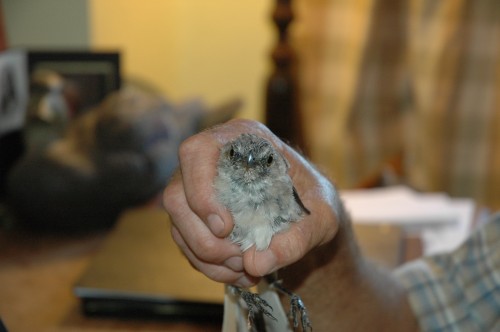
A natural showman, the mockingbird has a long reputation of being one of the feistiest entertainers in the animal kingdom. We had the opportunity to meet one, up close and personal, when he flew down our chimney this morning and flew into my office! Luckily I was able to catch the fidgety little fledgling and safely return him to the great outdoors.

Here's a blurry shot of me chasing him around the room -- man he's fast!
He was quick, but I was quicker!
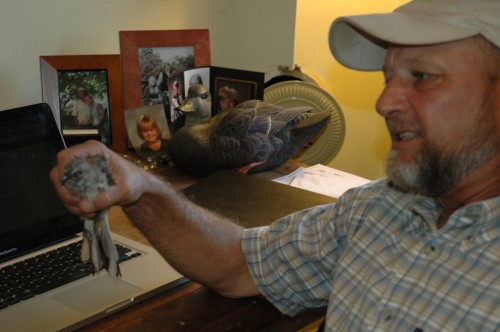
After a few minutes, I caught him long enough to pose for this picture!
After the paparazzi was finished, I released him outside so he could rejoin his momma!
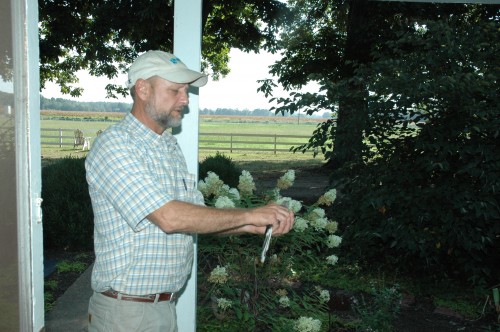
"Release the hounds"...er, i mean ...Mockingbird!
by Briscoe White | Aug 12, 2011 | Miscellaneous |
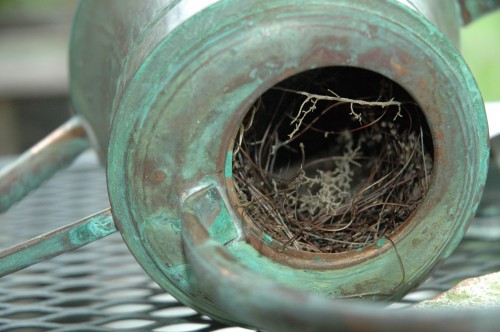
Carolina Wrens will nest just about anywhere...even in our empty watering can!
Carolina Wrens, though territorial about their range, are not picky about where they nest. Old boots, propane tanks, watering cans, mailboxes and pots…these are just some of the man made abodes that wrens have claimed as their “home sweet home”. Using everything from small sticks, moss and roots, to snakeskin, plastic bags, hair and paper, Wrens are resourceful home builders!
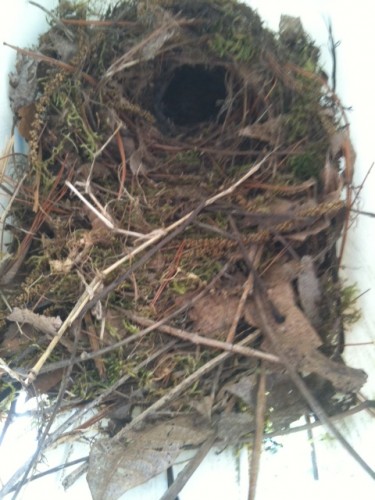
Wrens built this cozy nest in our marketing director, Caroline's, grandma's newspaper box!
The mating pair, which stays together for life, spend their time foraging for sturdy materials for the curved outer walls, and finish the inside up with softer nesting materials. Wrens may also build many mock nests throughout their territory, which are commonly called “cock’s nests”, choosing their favorite home for the nesting season once they are actually ready to mate. These domed nests are never used more than once and usually take about three days to construct. Once finished, the pair mate and the female lays a clutch of between three and seven small eggs that are cream colored with small brown speckles. To watch them in action, check out this great YouTube video of a pair of Carolina Wrens adding to their nest! Building a Carolina Wren Nest.
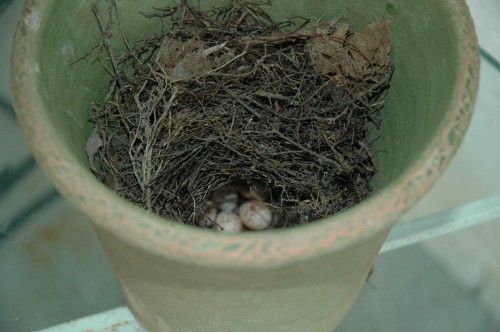
Our wrens chose the stylish pot on our office's front porch to nest in. They must not be bothered by the constant activity here since they've already laid eggs!
For a hilarious and heartwarming story with great pictures documenting the baby wrens, check out this website on the wren’s unusual nesting locations, and read about Karen Ouimet’s indoor wren experience!
by Briscoe White | Aug 2, 2011 | Miscellaneous |
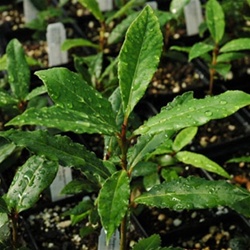
Back by popular demand, we have Bay Trees! OK well, to be fair, they never actually left, they’re just really hard to find. You can thank their high popularity rating as a savory, flavor-filled culinary herb and their slow rate of growth for that. Because we love them so much, and we know you all do, too, we’ve ensured a large crop for our shipping season this Fall, for all of your delicious holiday meals. If you’ve never grown Bay before, don’t worry. Read on or check out Briscoe’s Tips for some great information on how to keep this robust herb happy and healthy, all year round!
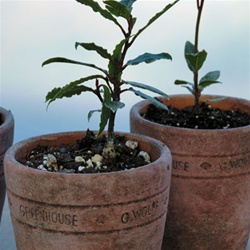
Bay makes a wonderful potted herb and if given well drained soil, and plenty of sun, you could literally grow a tree full of delicious Bay leaves. At its maturity, a Bay can reach about fifteen feet high and approximately twenty feet wide, but actually responds well to staying pruned into a container-planted shrub. Though Bays are more akin to turtle than hares, in terms of their growth rate, giving them the appropriate amount of space dictates their size quite a bit. Make sure than you give your Potted Bay a large enough planter, because, keep in mind, it IS a tree! That being said, a pot about twelve inches in diameter will grow your plant to about five feet tall before you need to re-pot your Bay into a larger container.
Bays have a shallow root system, and prefer fertile, well drained but moist soil. If the situation allows, leave your Bay outside while it’s nice and sunny to allow it to get full, unfiltered light, making sure that it doesn’t completely dry out while in the sun. If the outdoors is not an option, give your little tree as much direct, clear sunlight as possible. You may need grow lights to keep this herb happy throughout more dreary, cold months. While indoors, also beware of placing your plant near heating vents or where it could catch a draft from an open door. They can be VERY temperature specific!
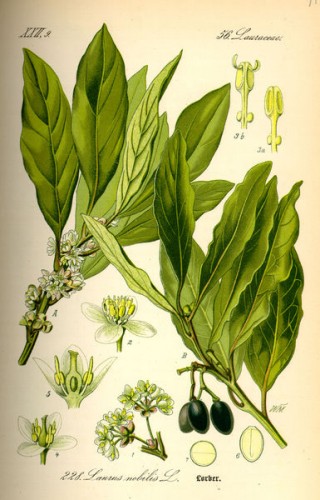
A native to the Mediterranean, Bay is also very useful outside of the kitchen and makes a highly beneficial medicinal herb. Bay contains healthful components that make it antiseptic, antioxidant and perhaps even an anti-cancerous herb. A wonderful source of vitamins A and C, folic acid, and B-Complex groups such as niacin, as well as many necessary minerals like potassium, calcium, iron and magnesium. Combining these powerful, health boosting properties, Bay is useful in healthy digestion, strengthening the immune system, healing to heal wounds more quickly, and among other things, aid in regulating your body’s metabolism. So while you may be adding this deliciously aromatic herb to your favorite recipe for its great flavor, you’re actually helping your body in lots of different way to stay healthier!
by Briscoe White | Jul 21, 2011 | Miscellaneous |

After seeing the pictures of me holding a hummingbird, some of you may be wondering “Wow, does he have lightening-quick, superhuman speed?!” Although I can can be quick on my toes, the story behind these pictures is not quite THAT phenomenal. (But it’s still a neat tale!)
It all started with our orchard. As a side project, I’ve been tinkering with growing peaches, apples, pears and cherries. It was early spring and I was preparing to spray the orchard with an organic-based insecticide to keep the bugs from enjoying the literal fruits of my labor. I’d parked my tractor outside of our office and ran in to check on things, leaving the door to my tractor cab open. When I returned, this little hummer was flitting around frantically inside, trying to find his way out. (I thought they were attracted to RED objects. My tractor is green. Maybe this guy was colorblind?) I gently followed him with my hand until he tuckered out long enough to land for a few brief seconds and just reached out and slowly grabbed him. When I touched him, it was as if he had gone into a faint, as he just went limp and let me pick him up. I guess he knew what was good for him! After taking a few quick photos, I let him go and he flew up into one of our trees out front. We’ve been keeping a close eye on our feeders and wondering which one might be him!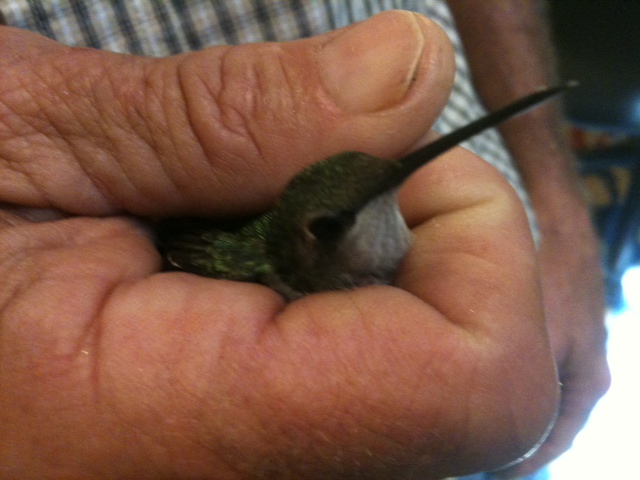
To attract some fast friends to your garden or yard, try placing multiple hanging and staked feeders in different areas, out of sight of each other. This will limit competition, as hummingbirds can be very territorial. Try mixing it up and placing some in trees in the shade, some staked in your garden near non-red flowers, and some right outside of your window to see which one they like the best!
Briscoe’s Hummingbird Fuel
For a great nectar mix to fill your feeders with, give this a try. Just remember to change the sugary mix weekly though, as it can go bad in the summer heat.
- 1 Cup White Sugar
- 4 Cups Water
Just bring the water to a boil and dissolve the sugar, stirring frequently. Let it cool, and add it to your feeders. Adding red dye isn’t necessary if you have a good, brightly colored red feeder. The dye just adds foreign chemicals to the bird’s diet which can’t be good.
by Briscoe White | Jul 21, 2011 | Miscellaneous |
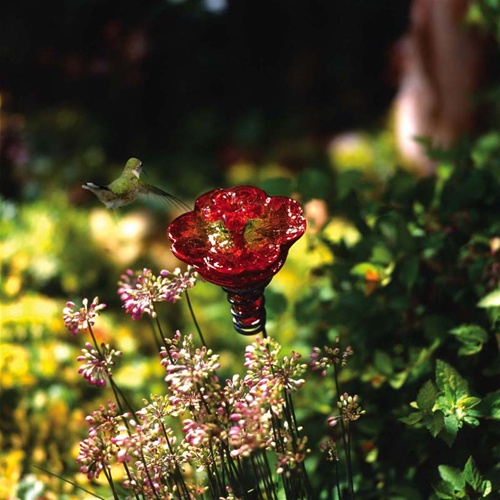
There are three varieties of Hummingbirds that frequent our area in Virginia, the Rufous, Allen’s and the Ruby Throated hummingbird. Our favorite is the last but not least in that list, for its brilliant hues and and signature ruby-red colored throat.
Highly curious and very attracted to feeders, the Ruby Throat is one of the most common and recognizable hummingbirds in the eastern half of North America. Living up to their name, males have vibrant green feathers, white stomachs and a red “ruby” throat, while females are larger and resemble males in coloring, but lack that namesake red throat. Hummingbirds often become so adapted to people that they may even dive closer to explore your red wardrobe, and seem indifferent to being watched closely while feeding near windows or patios. Hanging a hummingbird feeder near a large window is one of the most relaxing ways to pass time, as many males become territorial over their feeder and spend a lot of time chasing others away. (If hanging a feeder is difficult, we also have a great Staked Hummingbird Feeder that includes a stake for easy placement.) These fast, feathered air battles are more dramatic than your favorite soap opera and more entertaining than most sporting events! It’s best to place multiple hummingbird feeders throughout your yard, out of sight of each other, so that territorial lines aren’t crossed as often and everyone gets a chance to feed. Placing your feeders in the shade will also help give these hardworking hummers a respite from the hot summer sun!
Most of these hummers migrate to the deep south and Caribbean to wait out the cold winters, but tend to show back up with the blooming of spring flowers in late April and early June, here on the east coast. Beautiful and entertaining, these quick, little birds are terrific pollinators in your garden and drink half to eight times their body weight in nectar, and frequently dine on small, soft insects. During the sweltering summer months, make sure to change the sugary “nectar” in each of your feeders once a week, regardless of whether the birds have been feeding or not. This keeps the sugar-water fresh, as it will actually spoil in the summer heat. Though they love red, tubular shaped flowers, they will visit other sweetly-scented blossoms and blooming aromatic herbs as well. Try planting Asclepias ‘Tuberosa’, Bergamot and Lobelia to create a hummingbird habitat in your garden. Doing so will increase the health of your garden and give you a great, natural hive of activity to study!













